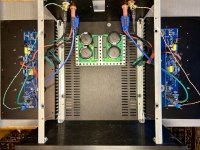My beloved Scryer has developed a cough. He is no longer scrying.
Recently I inadvertently left the system on overnight and discovered the next morning that the Scryer had a pulsing scratchiness and 1.5 VDC offset in one channel (Left) and slight mains hum in both.
I’ve got the Scryer splayed out like a Christmas turkey on the table and am trying to reason out what to troubleshoot. I disconnected the local cap bank and powered directly from my test supply and the same symptoms are there.
Where should I start? Lots of pictures? Measuring points for DC voltage?
Humbly awaiting guidance from the OmniLangstrump.
Recently I inadvertently left the system on overnight and discovered the next morning that the Scryer had a pulsing scratchiness and 1.5 VDC offset in one channel (Left) and slight mains hum in both.

I’ve got the Scryer splayed out like a Christmas turkey on the table and am trying to reason out what to troubleshoot. I disconnected the local cap bank and powered directly from my test supply and the same symptoms are there.
Where should I start? Lots of pictures? Measuring points for DC voltage?
Humbly awaiting guidance from the OmniLangstrump.
Attachments
first check/replace output mosfet - it's certainly most hard working element in chain
can't see/remember what you have as mosfet thermal arrangement (Keratherm, ALumina pad, mica), but it must be one of these
anyhow ........
measure Ugs for both SIT and mosfet ..... easy with one probe on hot speaker output, second probe to gates
check Iq
check DC Offset
and yes - you can measure voltage across level shifting resistor ( at IRF mosfet follower), write what value of resistor is used
write here
can't see/remember what you have as mosfet thermal arrangement (Keratherm, ALumina pad, mica), but it must be one of these
anyhow ........
measure Ugs for both SIT and mosfet ..... easy with one probe on hot speaker output, second probe to gates
check Iq
check DC Offset
and yes - you can measure voltage across level shifting resistor ( at IRF mosfet follower), write what value of resistor is used
write here
Keratherm is under the big fets.
Pictures attached for staring at goats while I get those measurements…
Is R237 the one you’re referring to?
Do I have the GDS correct in the last two photos (that’s my last spare SIT)?
Thanks for the guidance.
Pictures attached for staring at goats while I get those measurements…
Is R237 the one you’re referring to?
Do I have the GDS correct in the last two photos (that’s my last spare SIT)?
Thanks for the guidance.
Attachments
-
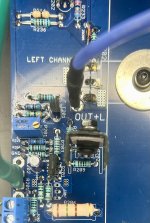 IMG_1650.jpeg543.2 KB · Views: 101
IMG_1650.jpeg543.2 KB · Views: 101 -
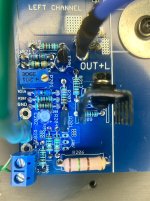 IMG_1651.jpeg451.5 KB · Views: 100
IMG_1651.jpeg451.5 KB · Views: 100 -
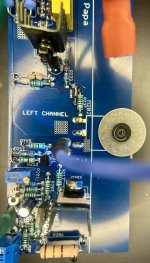 IMG_1652.jpeg423 KB · Views: 92
IMG_1652.jpeg423 KB · Views: 92 -
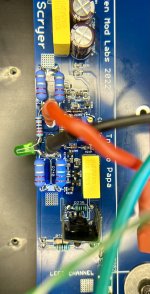 IMG_1653.jpeg328.9 KB · Views: 92
IMG_1653.jpeg328.9 KB · Views: 92 -
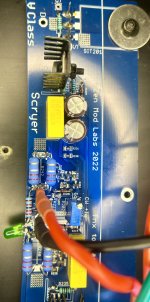 IMG_1654.jpeg344.4 KB · Views: 96
IMG_1654.jpeg344.4 KB · Views: 96 -
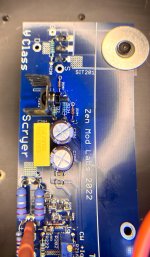 IMG_1655.jpeg340.8 KB · Views: 90
IMG_1655.jpeg340.8 KB · Views: 90 -
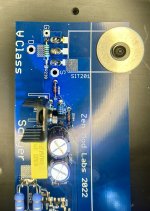 IMG_1656.jpeg435.3 KB · Views: 104
IMG_1656.jpeg435.3 KB · Views: 104 -
 IMG_1657.jpeg517.1 KB · Views: 99
IMG_1657.jpeg517.1 KB · Views: 99 -
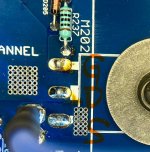 IMG_1658.jpeg308.6 KB · Views: 106
IMG_1658.jpeg308.6 KB · Views: 106
ref to schm in post #7, level shifting resistor is R134 (R234)
I'm saying that mosfet is working hard, not SIT; as far experience lead us to this moment, SITs are hard to kill or even damage, and I believe same applies for Baby SIT (2SK2037), not just big ones
gate resistors are R127 and R138, so that will tell you where gates of SIT and mosfets are
for both applies, G-D-S , from left to right, letters to ya, pins down

I'm saying that mosfet is working hard, not SIT; as far experience lead us to this moment, SITs are hard to kill or even damage, and I believe same applies for Baby SIT (2SK2037), not just big ones
gate resistors are R127 and R138, so that will tell you where gates of SIT and mosfets are
for both applies, G-D-S , from left to right, letters to ya, pins down
R234 is 120R
R234 3.5V and falling 1mV /sec
MOSFET ugs 4.17V stable
SIT ugs 1.67V slowly falling
Iq 165 mV across R240 slowly rising
DC offset 905 mV and climbing 1mV /sec
R234 3.5V and falling 1mV /sec
MOSFET ugs 4.17V stable
SIT ugs 1.67V slowly falling
Iq 165 mV across R240 slowly rising
DC offset 905 mV and climbing 1mV /sec
R134 is 120R
R134 3.47V and falling slowly
MOSFET ugs 4.29V stable
SIT ugs 1.98V slowly falling
Iq 180 mV across R140 climbing slowly
DC offset 30 mV and climbing slowly
R134 3.47V and falling slowly
MOSFET ugs 4.29V stable
SIT ugs 1.98V slowly falling
Iq 180 mV across R140 climbing slowly
DC offset 30 mV and climbing slowly
that for - non-scratchy side?R134 is 120R
R134 3.47V and falling slowly
MOSFET ugs 4.29V stable
SIT ugs 1.98V slowly falling
Iq 180 mV across R140 climbing slowly
DC offset 30 mV and climbing slowly
It appears I only have 9240s available.
.........
you can use that one - at least for test, and replace somewhere down the road
rotate it 180deg, use short wires to solder it to pcb, less work that way and no need to bend pins
I reflowed the SIT joints. No change.
Then I barely moved the offset pot and the offset jumped down to normal levels, below 25 mV. Scratchiness gone. Iq still at normal. ~168 mV.
Only the faintest of noise at the test speaker.
I’m gonna see if I can get the ‘good‘ side quiet.
Then I barely moved the offset pot and the offset jumped down to normal levels, below 25 mV. Scratchiness gone. Iq still at normal. ~168 mV.
Only the faintest of noise at the test speaker.
I’m gonna see if I can get the ‘good‘ side quiet.
Wacky! I had not experienced that before.
Second channel bias and offset adjustment went fine. However, I ran out of turns at 170mV for Iq. Couldn’t adjust lower. Way back when I first got this build running, I had changed R116 from stock 1K to 680R to allow for higher bias because I couldn’t get the current right. Then I switched SITs and that worked fine. Didn’t switch R116 back. I should probably do that. And put the 9140 back.

Second channel bias and offset adjustment went fine. However, I ran out of turns at 170mV for Iq. Couldn’t adjust lower. Way back when I first got this build running, I had changed R116 from stock 1K to 680R to allow for higher bias because I couldn’t get the current right. Then I switched SITs and that worked fine. Didn’t switch R116 back. I should probably do that. And put the 9140 back.

Give me a little time, Mozart.  You’re a bit fast for me.
You’re a bit fast for me.

Gotta let everything cook in safely.
I appreciate your support, nonetheless!
 You’re a bit fast for me.
You’re a bit fast for me.Gotta let everything cook in safely.
I appreciate your support, nonetheless!
It’s playing well in my secondary system with my ACP+. Settled in with no problems.
Thanks, ZM for your help! I ended up getting where I needed to go even if all I needed was a rebiasing and nulling of offset.
All roads lead to Rome.
Thanks, ZM for your help! I ended up getting where I needed to go even if all I needed was a rebiasing and nulling of offset.

All roads lead to Rome.
- Home
- Amplifiers
- Pass Labs
- Scryer ... or how F8 met Mighty SissySIT
